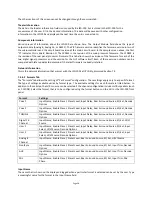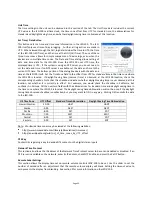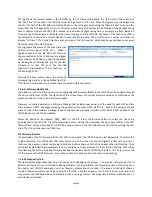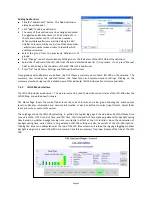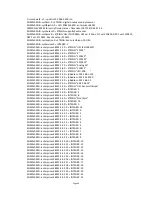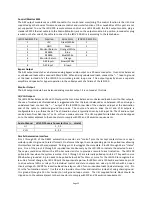
Page 41
8.
System Operation
The JSD-100 is controlled by the digital cinema server in most installations. Control is also available from the front
panel.
1.
USB Connector for communications. Select on the user interface
2.
COAX 1 – Rear Panel RCA type connector for PCM or optional Dolby Digital®
7
decoding.
3.
COAX 2 – Rear Panel RCA type connector for PCM or optional Dolby Digital® decoding.
4.
TOSLINK – An optical fiber connection for PCM or optional Dolby Digital® decoding.
5.
16 CHANNEL DIGITAL – AES Balanced line inputs. The channels 1-8 are standard. Channels 9-16 require the
optional DI-80 module.
6.
USER 1 – allows the selection and configuration of any input and any settings.
7.
USER 2 – allows the selection and configuration of any input and any settings.
8.
8 CHANNEL ANALOG – Balanced line inputs. Six channels (L, C, R, LFE, Ls, Rs) are fed through the unit with
appropriate delays and EQ. The two remaining channels may be configured as Lc/Rc (7.1SDDS) or Lrs/Rrs
(7.1DS).
9.
NON-SYNC – 2 Channel Analog Unbalanced Line Input. Input sensitivity and level may be adjusted.
10.
AUX – 2 Channel Analog Unbalanced Line Input. Input sensitivity is fixed but input level may be adjusted.
11.
MIC – Public Address Balanced line input. Input sensitivity and level may be adjusted.
12.
MUTE – mutes all outputs.
13.
Display – indicates the Fader level, format input and bar graph display of the output signal levels.
14.
Power Indicator LEDs – displays status of power supply voltages.
15.
Power Switch – On for normal operation, off for bypass operation.
16.
Fader – Controls the overall volume of all the channels.
8.1
Front Panel
The input select buttons choose which input is to drive the auditorium speakers. The LED above the button will
light when that input is selected. If the selected input is digital, but no digital signal is available, the LED will flash.
Pressing the “mute” button controls muting of the auditorium speakers. The LED above the button is lit when the
system is muted.
The display shows the current main fader level, the user defined name of the currently selected format, and a bar
graph showing the measured audio levels on each output. The number of bars and the labels under the bars varies
with speaker configuration. When the speaker configuration includes use of the JSD-100 internal crossovers, the
bar graph shows the low band in yellow, the mid-band in green, and the high band in blue. Full range outputs (such
as the surround channels, HI, VI-N) are shown in green. When an AES output board is used, the bargraph indication
is relative to the headroom setting. For example, if the headroom is set to 26dB, the bargraph indicates 0dB when
the output level is -26dBFS.
The Main Fader adjusts the output volume. As it is adjusted, the display is updated to show the new fader level.
Note that the fader level will generally change on a format change. If the format has a preset fader level, the fader
7
Manufactured under license from Dolby Laboratories. Dolby and the double-D symbol are trademarks of Dolby Laboratories.
Summary of Contents for JSD-100
Page 12: ...Page 12...


